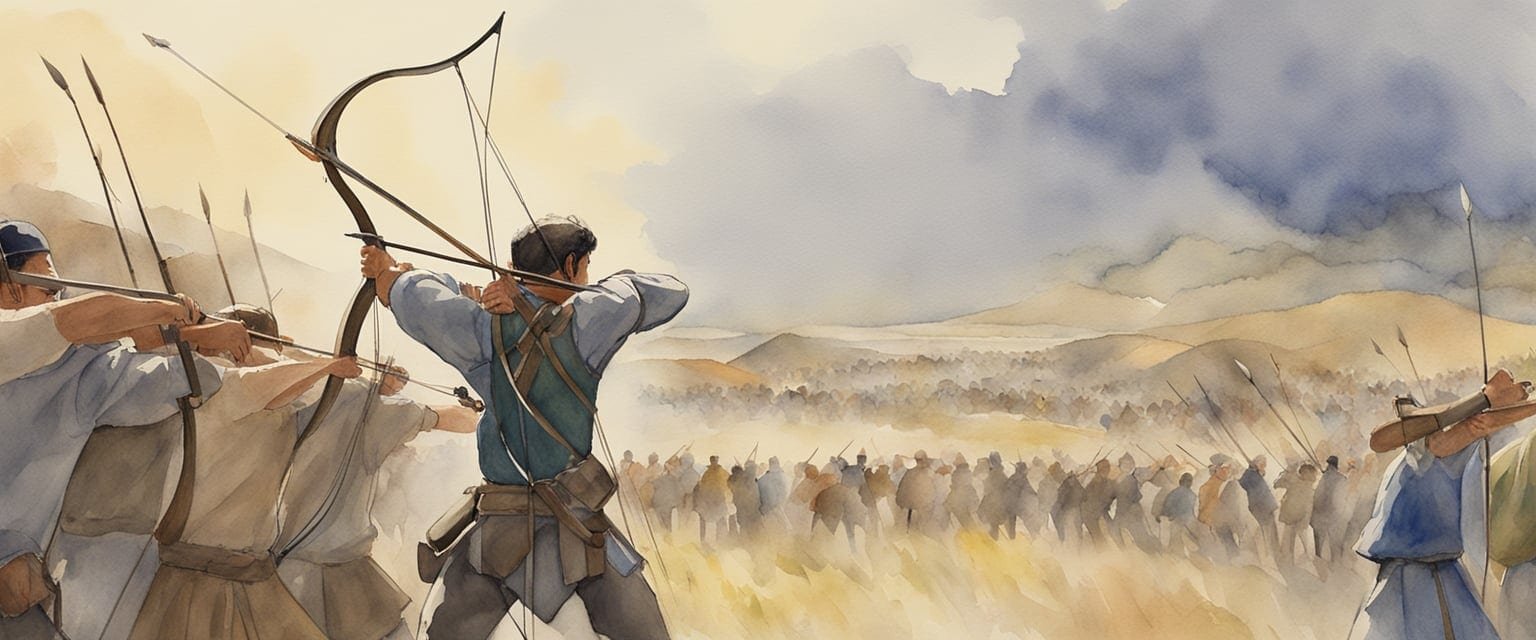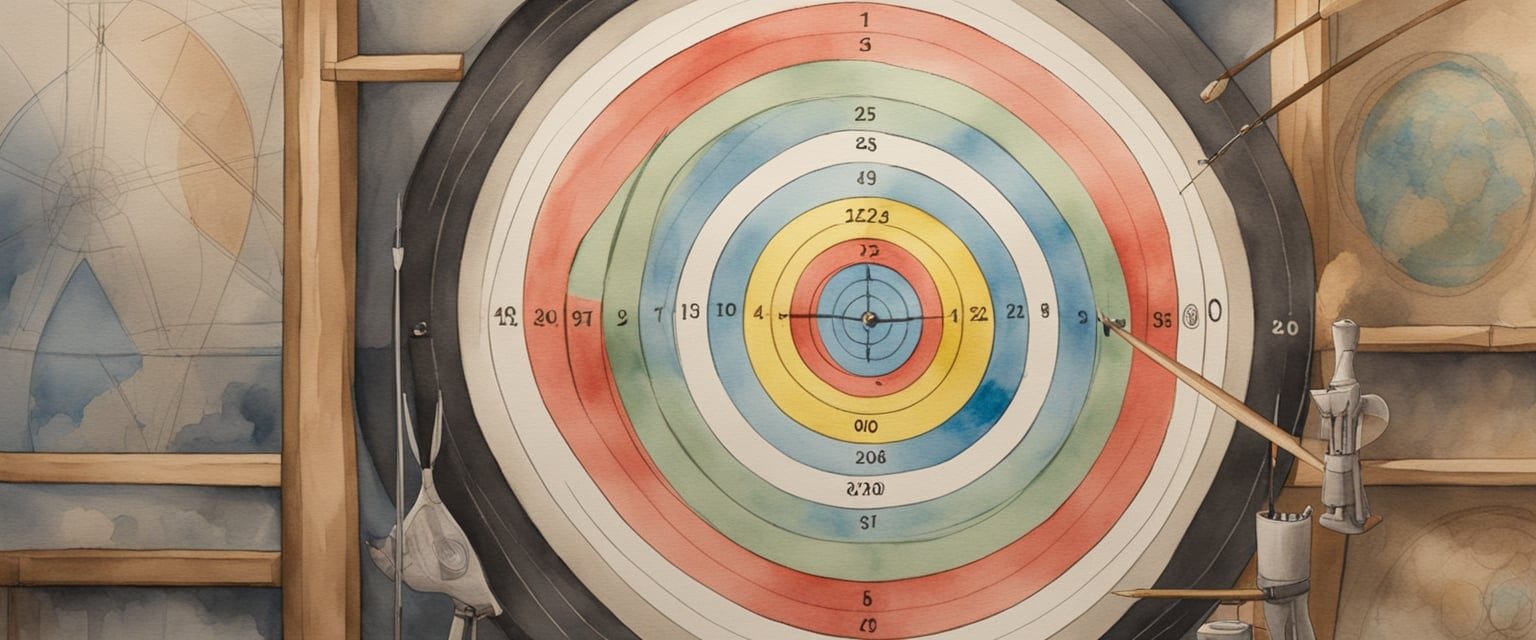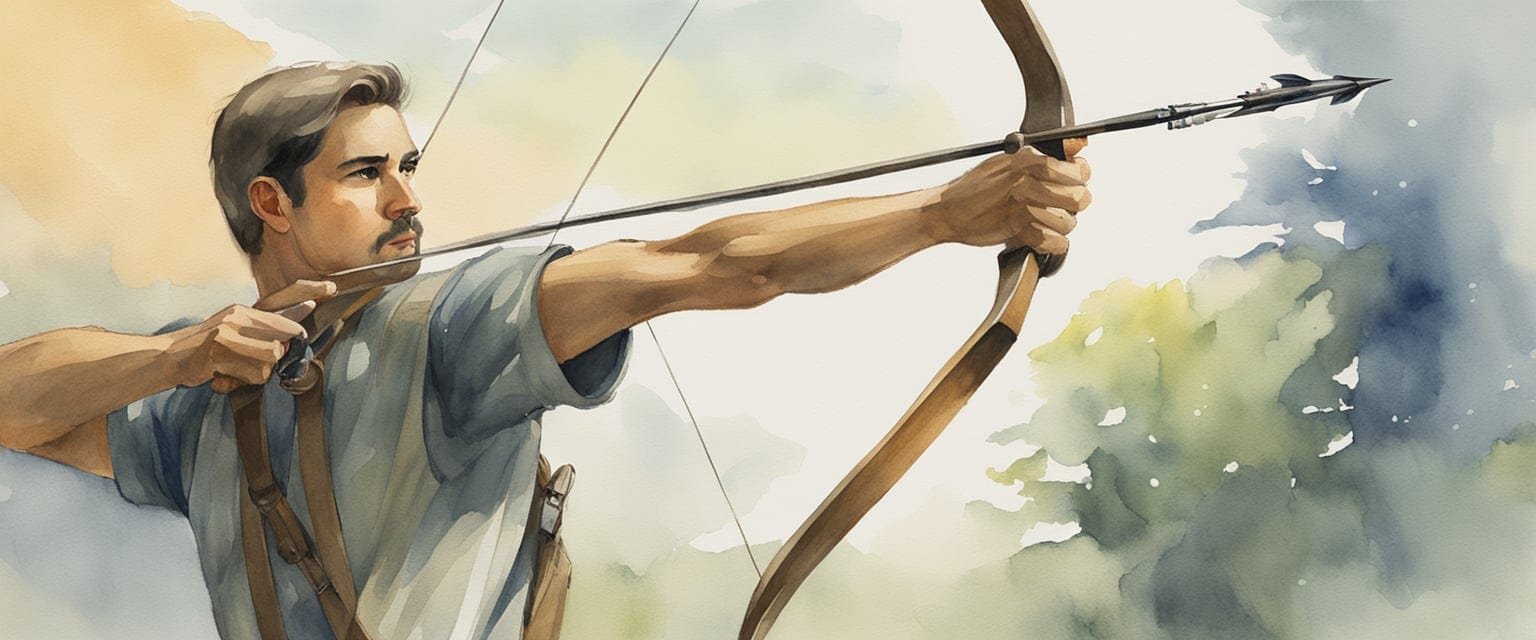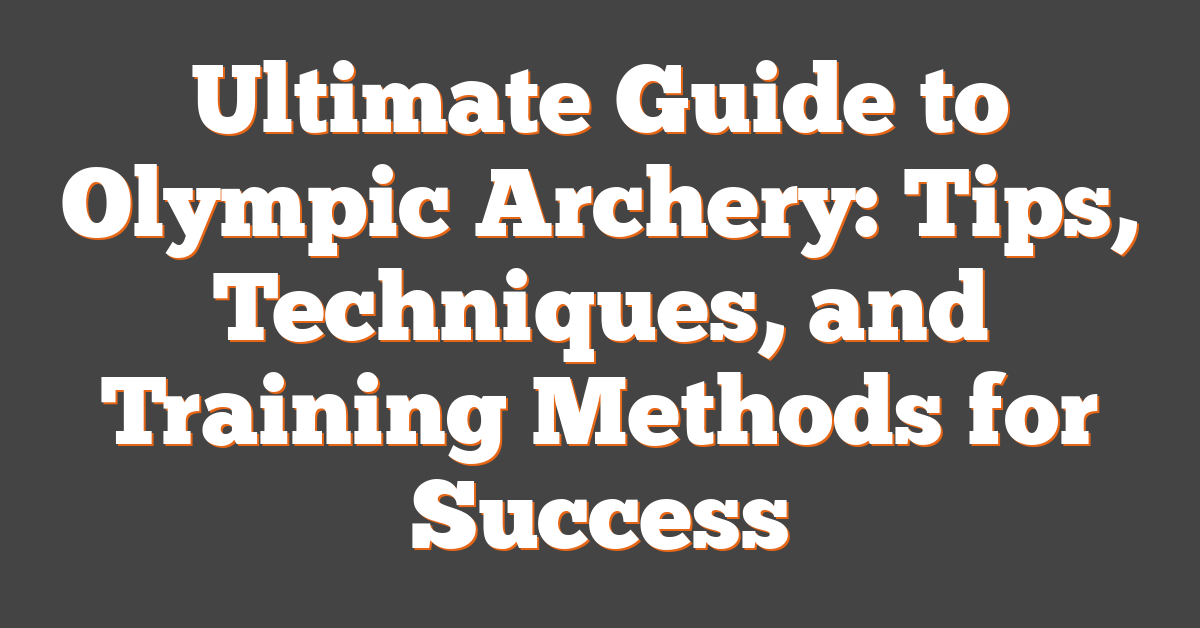Olympic archery is a sport steeped in history, showcasing the skill and precision of archers from around the world. This ultimate guide will provide you with everything you need to know about Olympic archery, from its evolution to the techniques used by top competitors. Whether you are new to the sport or a seasoned fan, understanding the aspects of Olympic archery can deepen your appreciation for this exciting event.

As we explore the various elements of Olympic archery, you’ll get insights into the rules, equipment, and training methods that shape success at the Games. From the rich traditions that have defined archery for centuries to its modern competition formats, there’s a lot to dive into. I invite you to join me on this journey to uncover what makes Olympic archery both a thrilling sport and a fascinating cultural phenomenon.
Key Takeaways
- Olympic archery has a rich history and has evolved significantly over the years.
- Understanding the equipment and techniques enhances appreciation for the sport.
- Competition formats and scoring play crucial roles in determining the champions.
History and Evolution of Olympic Archery

Archery has a rich history that connects ancient traditions with modern Olympic competition. In this section, I will explore its origins, the changes in rules and formats throughout the years, and some of the great archers who have left a lasting legacy in the sport.
Origins and Early History
Archery dates back thousands of years. It originated as a hunting tool but evolved into a competitive sport. The first Olympic archery events took place in the 1900 Paris Games. This marked the start of archery within the Olympic framework, where both men and women competed in various categories.
In those early competitions, archers shot at targets from different distances. Notably, the 1904 Olympics in St. Louis expanded the program to include three women’s events. This early inclusion of women set a precedent for future competitions.
Changes in Rules and Format Over the Years
Since its debut, the rules and formats of Olympic archery have seen significant changes. Initially, the structure was less standardized, leading to varied shooting styles and scoring systems. Over the decades, governing bodies, like World Archery, established clearer rules.
For instance, 1972 marked the reintroduction of archery into the Olympics after a long absence. Now, archers shoot at a target that is 122 cm in diameter from distances of 70 meters, using a more reliable scoring system. The move to standardized equipment and rules has made the sport more competitive and fair.
Archery Greats and Olympic Legacy
Throughout Olympic history, several archers have made their mark. Darrell Pace, a World Archery Champion, won two gold medals at the 1976 and 1984 Olympics, setting records that still stand today. His precision and skill inspired many aspiring archers.
Other notable archers include Kim Woo-jin and Brady Ellison, who have pushed the boundaries of the sport and brought attention to archery worldwide. Their achievements and sportsmanship contribute to the rich legacy of Olympic archery, inspiring future generations to take up bows and arrows.
Understanding the Sport
Olympic archery is a fascinating and competitive sport that combines skill, focus, and precision. It involves specific equipment and various competitions, which I will explain in detail here.
The Basics of Olympic Archery
In Olympic archery, archers use a specific type of bow known as a recurve bow. This bow has tips that curve away from the archer when unstrung, providing more power and accuracy. Competitors shoot arrows at a target placed at a distance of 70 meters.
Each archer takes turns firing arrows, and the goal is to score points by hitting specific areas on the target. A perfect score is achieved by hitting the bullseye, worth 10 points. The rules are strict, and the use of proper techniques is crucial for success.
Categories of Competition
Olympic archery includes several categories, catering to different types of athletes. The main events are individual competitions and team events.
Individual Competitions: Each archer competes solo against others in a series of elimination rounds. The last archer standing wins the gold medal.
Team Competitions: This event allows archers to work in pairs or groups. Each team’s total score is combined to determine the winner.
Mixed Team Events: This exciting format includes one male and one female archer competing together. It showcases teamwork and strategy.
Olympic Archery Equipment
The equipment used in Olympic archery is highly specialized. Here are the main pieces:
Recurve Bow: The primary bow used in competitions, designed for accuracy.
Arrows: Made from lightweight materials like carbon or aluminum, they are crafted for speed and precision. They vary in length and weight based on the archer’s preference.
Targets: A target in Olympic archery is a circular disc with different scoring zones. It measures 122 cm in diameter, which is standardized for competitions.
Additional Gear: Archers often use finger tabs or gloves for a better grip, along with arm guards to protect against string snaps.
Understanding these aspects will enrich my appreciation for this thrilling sport.
Olympic Archery Techniques
In Olympic archery, mastering specific techniques is essential for success. Key elements like stance, aim, and mental focus play crucial roles in improving my performance. Each technique requires practice and attention to detail.
Stance and Form
My stance is the foundation of my shot. A stable, balanced position helps me maintain control. I stand with my feet shoulder-width apart and shift my weight slightly onto my front foot. This setup allows me to be steady during the shot.
I also pay attention to my body alignment. Keeping my shoulders square to the target is important. This alignment helps me draw back the bowstring evenly. I usually ensure my head is level, with my chin down, aiming directly at the target.
Proper form when holding the bow is essential too. I grip it firmly yet relaxed. A strong grip keeps the bow steady, while a relaxed hand allows for smooth release.
Aiming and Release
Aiming is all about focus and precision. When I draw back my bow, I take a deep breath and visualize the target. I concentrate on the center of the target and align my sights accordingly.
As I release the arrow, it’s important to do so smoothly. I keep my hand steady and allow the string to slide off my fingers without jerking. My goal is a clean release, allowing the arrow to fly straight.
I always remind myself to follow through after the shot. This means keeping my stance and my bow arm in position until the arrow hits the target. It helps ensure my aim was true.
Mental Focus and Precision
Mental focus is just as crucial as physical technique. To perform well, I practice visualization techniques. I imagine each step of my shot in detail, from stance to release.
Staying calm under pressure helps me maintain precision during competitions. I use breathing techniques to center myself before I shoot. This keeps distractions at bay and helps me concentrate fully.
I also believe in the importance of routine. Having a consistent pre-shot routine allows me to mentally prepare. It helps create an environment conducive to focus, improving my overall performance.
Competition Format and Scoring
In Olympic archery, the competition format and scoring are essential for understanding how athletes perform and how matches are decided. This section will cover the set system used in matches, how scores are calculated, and what happens in the case of a tie.
The Set System in Olympic Archery
The set system is a unique format that makes Olympic archery exciting. In this system, each match consists of multiple sets. Each set includes six arrows, three arrows per archer.
To earn points in a set, an archer must score higher than their opponent. The winner of a set gets 2 points, while the loser receives 0 points. If both archers score the same, they split the points 1-1. The match continues until one archer reaches 6 points, which means they have won three sets. This format keeps the competition engaging and allows for strategic play.
Scoring during the Matches
Scoring in Olympic archery is precise and straightforward. Each arrow hit within the target’s scoring zones receives points based on where it lands.
The target has five scoring rings:
- 10 points for the inner circle (bullseye)
- 9 points for the next ring
- Continuing down to 1 point for the outer ring
After all six arrows are shot in a set, the total points are calculated. The highest score determines the set winner. If the scores tie, each archer receives 1 point for that set. Understanding this scoring helps me appreciate the skill and focus required by archers.
Tiebreaks and Shoot-offs
Tiebreaks are critical when the competition is tight. If archers are tied after all sets, a shoot-off determines the winner.
During a shoot-off, each archer shoots one arrow. The archer whose arrow lands closest to the center of the target wins. If both arrows land at the same distance from the center, they will continue to shoot until one archer wins. This sudden death format adds tension and excitement to the event, showcasing the nerves and skill involved in Olympic archery.
Notable Events and Matches
Olympic archery has a rich history filled with exciting competitions. It features thrilling individual challenges and impressive team events. Here are some highlights that stand out.
Individual and Team Competitions
In Olympic archery, there are individual and team events that showcase the skills of archers. The individual competition includes both men’s and women’s categories, where each archer shoots a set number of arrows.
Team events consist of groups of three archers from the same country. They work together to achieve the highest score. Mixed team events, introduced in the 2020 Tokyo Olympics, feature one male and one female archer competing together.
South Korea often dominates these competitions, winning numerous medals over the years. Their teamwork and precision make them a force to reckon with.
Memorable Olympic Archery Matches
Throughout Olympic history, some matches have stood out due to their intensity and drama. One notable match was the showdown between Korea’s Ki Bo-bae and Great Britain’s Naomi Folkard during the 2012 London Olympics. Ki Bo-bae’s skill secured her a gold medal, showcasing her strength under pressure.
Another unforgettable moment was in 1988 when South Korea’s team faced the United States in the finals. The match was incredibly tight, but South Korea took the gold. This event marked a shift in Olympic archery, highlighting the rise of Asian archers in the sport.
Top Performing Countries in Olympic Archery
When discussing Olympic archery, certain countries consistently shine. South Korea is the most successful nation, dominating both individual and team events since the 1980s. Their archers have won numerous gold medals, establishing them as leaders in the sport.
The United States and China are also strong contenders in various competitions. They have brought home multiple medals in both individual and team events.
Countries like Russia and Japan have made significant impacts too, often surprising audiences with their skill. The competition continues to grow, making every Olympic Games thrilling for fans and archers alike.
Olympic Archery Equipment Detail
When it comes to Olympic archery, the right equipment can make a big difference. Each piece has a specific purpose that contributes to performance and precision. Let’s break down the essential components of a recurve bow and the accessories that support archers in competition.
The Anatomy of a Recurve Bow
The recurve bow is the primary weapon used in Olympic archery. Its unique design features a curved shape that helps increase arrow speed and accuracy. Understanding its parts is crucial for any archer.
- Limbs: These are the flexible sections that bend when the bow is drawn. They store energy, making the bow more powerful.
- Riser: This is the central part of the bow where the grip is located. It helps to hold the bow steady while aiming.
- Grip: Wrapped in comfortable material, the grip allows me to hold the bow securely.
- Nock: This is the small notch at the end of the bowstring where the arrow is placed. It ensures consistent arrow placement.
- Shaft: The shaft is the long body of the arrow. It can be made from materials like aluminum or carbon for strength and weight considerations.
Accessories and Gear
In addition to the bow, I rely on various accessories to improve my accuracy and comfort while shooting.
- Finger Tab: This protective piece I wear on my drawing hand helps improve my grip on the string and prevents injury.
- Quiver: A quiver holds my arrows. It can be worn on my hip or back, allowing for quick access during competitions.
- Stabilizers: These attach to the bow to help balance it. They minimize wobbling, which enhances my aim.
- Vibration Dampener: This helps reduce noise and vibration from the bow after I shoot, contributing to a smoother experience.
Having the right equipment makes a significant difference in my performance, aiding in my focus and precision during competition.
Preparing for Olympic Archery
Preparing for Olympic archery takes careful planning and dedication. Each component plays a vital role in building a successful archer. I will cover training regimens, the importance of mental and physical conditioning, and the Olympic qualification process.
Training and Practice Regimens
Training is the backbone of any athlete’s journey. I focus on consistent practice to develop skills. A typical week includes shooting sessions, aiming to enhance precision. I often break my practice into different parts: target distance, technique, and endurance.
I use a methodical approach that involves:
- Short sessions for focus and retention
- Longer sessions for endurance and consistency
In addition, incorporating variations like different distances and conditions keeps my skills sharp. I might also participate in competitions to simulate the pressure of real events.
Mental and Physical Conditioning
Mental strength is just as crucial as physical ability in archery. I practice techniques like visualization and mindfulness to stay focused during competitions. This helps me maintain composure when the pressure increases.
For physical conditioning, I blend strength training with flexibility exercises. Regular workouts improve my posture and stability, which are essential for accurate shooting. I keep a balanced diet to fuel my body and optimize performance, focusing on hydration and nutrition before training sessions.
Qualification and Selection Process
The Olympic qualification process is rigorous. I must perform well in several competitions to earn my spot. Each country has its own criteria, often including national championships and specific ranking events.
I track my progress through a points system, aiming to achieve the required score. Competing against other skilled athletes is challenging but also motivates me to improve. Understanding the ranking system and knowing where I stand helps me set achievable goals leading up to the Olympics.
With commitment and a strategic plan, I can better position myself for success in Olympic archery.
Olympic Archery in Pop Culture
Archery has made a significant impact on popular culture, reflecting its historical roots and modern appeal. From movies and TV shows to the influence it has on recreational practices, archery captures the imagination in many ways.
Media Representation of Archery
I’ve noticed archery featured prominently in films and television. Characters often use bows as symbols of heroism, skill, or even mystique. In movies like “The Hunger Games” or “Brave,” archery is central to the plot, making it exciting to audiences.
Television shows also highlight competitive archery, showcasing tournaments and athletes. This representation not only entertains but also educates viewers about the sport’s nuances. Several documentaries focus on Olympic archers, revealing their dedication and training.
This visibility helps to demystify archery, transforming it from a niche activity into a more mainstream one in popular media.
Influence on Recreational Archery
As I explore recreational archery, I’ve seen how popular culture influences interest in the sport. Many people are inspired to take up archery after watching it in movies or on their favorite shows.
Clubs and courses report a rise in participation, especially after major events like the Olympics. Some even host themed events, drawing in fans who want to learn archery skills. Popular games, such as “The Legend of Zelda,” incorporate archery, further encouraging fans to pick up a bow.
This influence helps create communities centered around archery, connecting enthusiasts through shared interests that stem from media.
Future of Olympic Archery

I see a bright future for Olympic archery, shaped by innovation and a growing global presence. As technology advances and new designs for bows emerge, the sport will likely attract more fans and participants from around the world.
Innovations and Technology
New technologies are transforming the way archery is practiced and viewed. For instance, advances in bow design have made equipment lighter and more accurate.
Key innovations include:
- Smart bows with sensors to analyze archers’ performance.
- Enhanced materials, such as carbon fiber, that improve durability.
- Digital tools for training and strategy, helping athletes refine their skills.
At the Paris Olympics, I expect to see these technologies showcased, making competitions more exciting and accessible. Fans can look forward to a more dynamic experience, with real-time data and insights enhancing their understanding of the sport.
Growth of the Sport Globally
Archery continues to grow in popularity around the world. More countries are investing in archery programs and facilities, which helps develop new talent.
I am excited to see initiatives like:
- Increased access to equipment for youth programs.
- Community-based training sessions that encourage participation.
- International competitions that provide a platform for emerging archers.
Events like the Paris Olympics will serve as a catalyst for this growth. As countries focus on promoting archery, I believe we will soon witness a surge of interest that enhances the sport’s visibility and participation rates.
Frequently Asked Questions

I often get questions about Olympic archery, especially around the equipment, rules, and training needed for competition. Here’s a closer look at some common inquiries I hear.
What type of equipment is used in Olympic archery?
Olympic archers use recurve bows, which are designed to bend away from the archer when unstrung. This shape gives them more power and speed. They also use specific arrows made for accuracy, a finger tab or release aid, and a quiver to hold their arrows.
How much does a typical Olympic archery bow cost?
The cost of an Olympic archery bow can vary widely. A basic recurve bow can start around $300, while high-end models often exceed $1,000. Custom bows can go even higher, depending on the materials and brand.
At what distance do archers shoot during Olympic competitions?
During Olympic competitions, archers shoot at a distance of 70 meters from the target. The target has a diameter of 122 centimeters and is composed of ten scoring rings.
Can you explain the basic rules for Olympic archery?
In Olympic archery, each archer has a set time to shoot their arrows, usually 20 seconds each. They shoot a total of 72 arrows in the ranking round to establish their score. The aim is to hit the center of the target for the highest points.
What does it take to become an Olympic archer?
To become an Olympic archer, you need a lot of practice and dedication. Most archers start at a young age and participate in competitions to gain experience. Physical fitness, mental strength, and coaching are also important for success.
Which bow is considered the best for competing in Olympic archery?
The best bow for Olympic archery often depends on personal preference and body type. Many archers prefer brands like Hoyt, Win&Win, or Samick, which are known for their high-quality recurve bows. It’s essential to try different bows to find the right fit for you.

